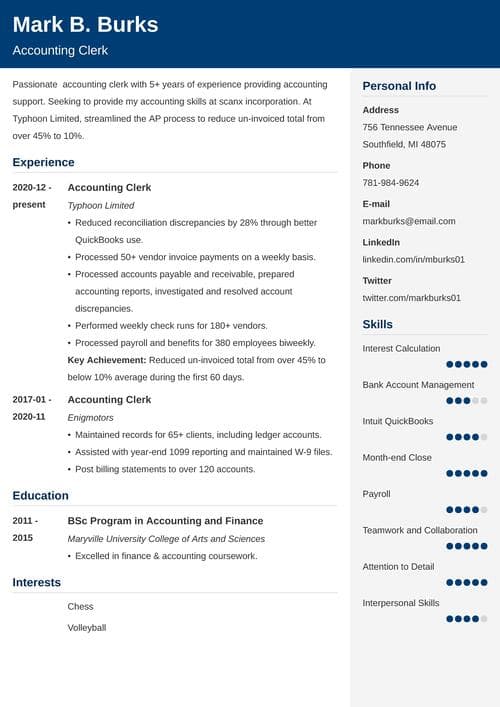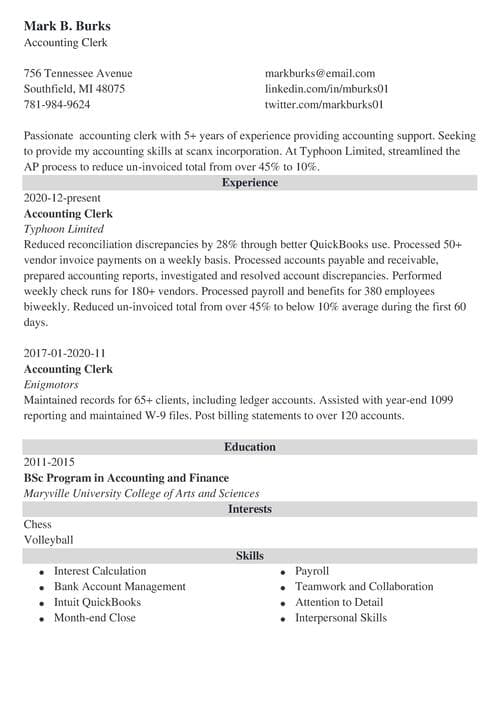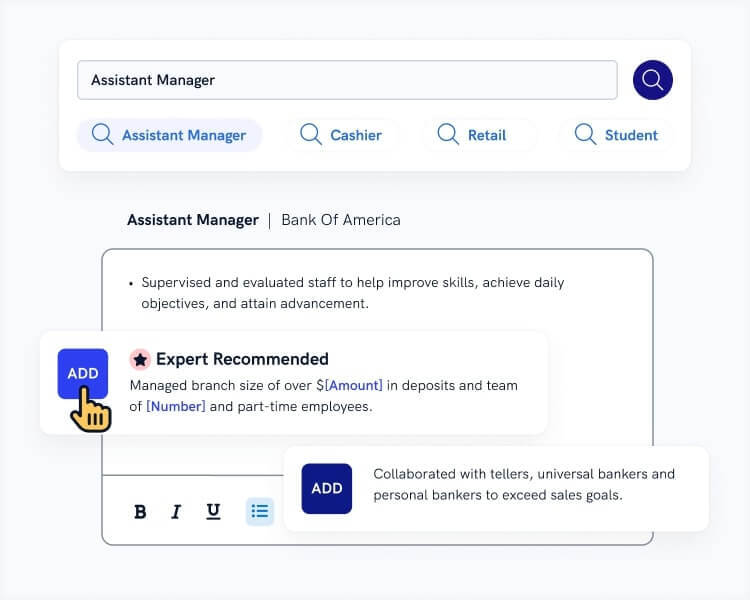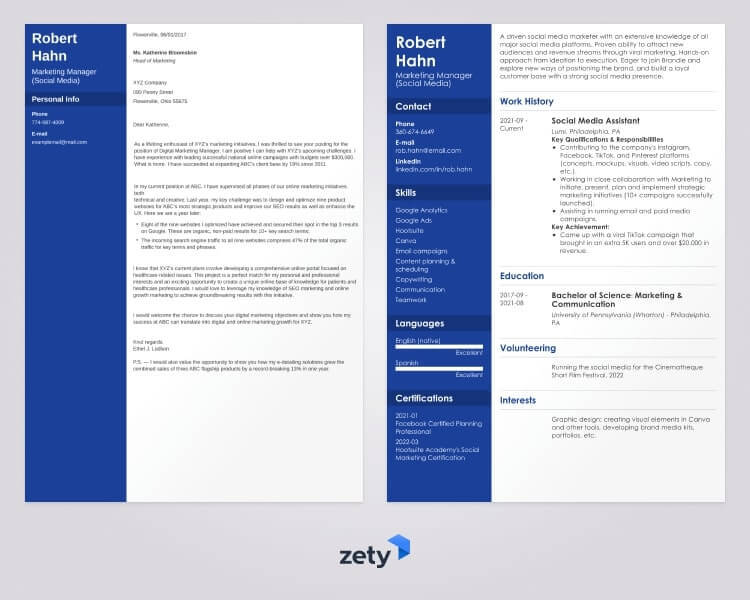Applying for a job in the USA means following some American application standards. This might be tricky, and not only for a foreigner.
Read on to learn all about the US resume format, what to include, what to skip, and what to keep in mind when applying from abroad.
Want to save time and have your resume ready in 5 minutes? Try our AI resume builder. It’s fast and easy to use. Plus, you’ll get ready-made content to add with one click. See 20+ resume templates and create your resume here.
Sample resume made with our builder—See more resume examples here.
After reviewing 11 million resumes created with our builder, we’ve collected valuable insights from users spanning different industries and levels of experience. Here are the top takeaways to help you design a more effective resume:
Data-Backed Insights From Actual Resumes
- 57.84% of resumes made with our builder are over 300 words, 28.23% are between 101 and 300 words, and 5.35% are under 100 words.
- 3.59% of our users have no work experience, while 28.86% report having less than 3 years of experience.
- Resumes typically list an average of 12.56 skills.
- On average, resumes include 2.61 previous jobs.
Looking for US resume examples for specific situations? See:
- Entry Level Resume
- Resume with No Work Experience
- Resume for a Part Time Job
- Internship Resume
- Student Resume Template
- College Graduate Resume
- College Application Resume
- Scholarship Resume
- Resume for Graduate School
- Resume Example for 500+ Jobs
- Samples of Curriculum Vitae for 500+ Jobs
US Resume Example
Melanie Lee
Accountant
123-456-7890
melanielee@email.com
linkedin.com/in/melanie.lee
Summary
Detail-oriented Certified Public Accountant (CPA) with 6+ years of experience. Eager to support LedgerCraft Solutions in accurately managing their financial operations using strong organizational skills. Improved cost savings by 15% at AccuPros Accounting through efficient budget analysis.
Experience
Senior Accountant
AccuPros Accounting, Syracuse, NY
January 2015–Present
Key Qualifications & Responsibilities
- Oversaw financial transactions and account analysis.
- Preparing and presenting 10 quarterly financial reports.
- Conducting internal audits.
- Mentoring 5 junior accountants.
Key Achievement:
- Improved cost savings by 15% through efficient budget analysis.
Assistant Accountant
FiscalFlare Financial Services, Syracuse, NY
June 2012–December 2014
Key Qualifications & Responsibilities
- Assisted in the preparation of financial statements.
- Conducted account reconciliation.
- Assisted in payroll processing.
Key Achievement:
- Introduced an advanced Excel tracking system, which increased overall productivity by 20%.
Education
Bachelor of Science in Accounting
Le Moyne College, Syracuse, NY
August 2008–May 2012
Academic achievements
- Graduated with Cum Laude honors
- Accounting Club President (2011–2012)
Skills
- Financial reporting
- Budget management
- Proficient in QuickBooks and MS Excel
- Auditing
- Excellent communication skills
- Team leadership and mentoring
- Problem-solving abilities
- Time management
Certifications
- Certified Public Accountant (CPA), American Institute of CPAs, 2012
Memberships
Member of the American Institute of CPAs since 2012
- Attended yearly AICPA conferences to keep up-to-date with the latest accounting practices.
Languages
- English—Native proficiency
Interests
- Volunteering at a local animal shelter.
- Participating in weekend chess tournaments.
What Is US Resume Format?
An American resume is typically a one-page document similar to a CV. The US resume format lays information out in reverse-chronological order: you start with your most recent job and make your way back in time. American resumes often start with a heading statement, followed by experience, education, and skills.
You may be surprised, but there are very few differences between American resumes and CVs:
American Resume Template
1. Format
The most popular resume format in the US in the reverse-chronological format which puts the focus on your professional work experience. Alternatives include the functional resume format and combination resume format. Standard US resumes are one page long.
If you’re unsure what format to choose, read on: Best Resume Format (+Samples)
2. Header with Contact Information
Add your contact information at the top of your resume so that recruiters know how to get in touch. This should include your name, contact phone number, and email. If you have a relevant website or online portfolio or an up-to-date LinkedIn profile, add that too.
Pay very close attention to information that should not be found in an American resume since it can exclude your resume from the start. We’ll mention this later on.
Read more: Resume Header Examples
3. Resume Profile
Your resume profile should be a short, relevant introduction about yourself and why you’re applying for the position.
- If you’re already an experienced professional, use the resume summary statement that will focus on your job experience.
- If you’re just starting your career, use a resume objective statement that focuses on your skills and your career goals.
Remember to keep it brief. Your summary of qualifications and skills shouldn’t be any longer than 5 sentences.
Check how to write a resume profile: How to Describe Yourself on a Resume
4. Work Experience
This section will be the main part of your American resume and include your relevant work experience.
You should include the name of the company you worked for, its location, your employment dates, the title of your position, and a short list of primary job responsibilities.
Here are a few tips:
- Mention your relevant job responsibilities in bullet points using action words.
- Add 6 bullet points for your most recent position and fewer as you go back in time.
- Don’t go back further than 15 years in your career experience.
- Use resume keywords to raise your chances of passing computerized recruitment systems that scan your resume for specific phrases.
- Tailor your resume to the job description.
See how to craft the perfect work experience section for your US resume: Resume Work Experience, History & Example Job Descriptions
5. Education
As the name suggests, this is the section where your education goes.
Mention your highest degree (if applicable; skip listing high school if you already have a college degree), school name, and location (city, country).
Different countries have different degrees and mastery so make your level of education as clear as possible (avoid abbreviations or jargon).
If you lack job experience, feel free to mention relevant coursework you’ve done to boost your credentials.
There’s no need to add a GPA or your grades. Most internationally grading systems most likely won’t be understood by US recruiters anyway.
School yourself on how to add your education to your resume the right way: Education on a Resume Made Simple
6. Skills
List the job skills you have. Then take a look through the job ad and highlight the skills the employer is looking for.
Do any of the skills on both lists match? Mention those skills on your US resume.
Don’t mention every skill you ever had.
Remember to make your skills section a nice balance between hard and soft skills since employers value both. In fact, it’s demand for soft skills that’s on the rise!
Go more in depth on skills, their different types, and what employers value in this guide: Work Skills That Should be on Your Resume
7. Additional Sections
This section is the perfect place to add any extra interests or accomplishments that hiring managers might be interested in and that will make you stand out from the crowd.
These can usually be divided into the following categories:
- Certificates and Licenses
- Hobbies and Interests
- Foreign Languages
- Achievements and Awards
- Publications
- Internships
Remember, this isn’t a chance for you to show off in front of your mother who will think that the fact you like cats and collecting buttons is wonderful. Keep it relevant to the job you’re applying for.
Read more: What Sections and Categories to Add to a Resume
US Resume Formatting
Zety’s HR statistics report proves that a recruiter usually looks at it a resume for an average of only 7 seconds. That’s why delivering all the necessary and relevant details about your candidacy is so critical.
Here are some quick tips to make your American resume win:
- Choose a professional resume font like Arial, Calibri, or Times New Roman. Set its size to 11–12 points.
- Adjust the resume margins to 1 inch on each side and select a single line spacing.
- Keep to the right resume length. One page will be enough, but if you have a lot of relevant information to highlight, you can also aim for a two-page resume.
- Name your resume: “Your Name–Job Title–Resume”.
- Save your resume as a PDF file, to keep the format intact. Do it always unless another type of file is required.
- Leave some white space in your resume to make it more pleasant to read.
See the resume outline below:
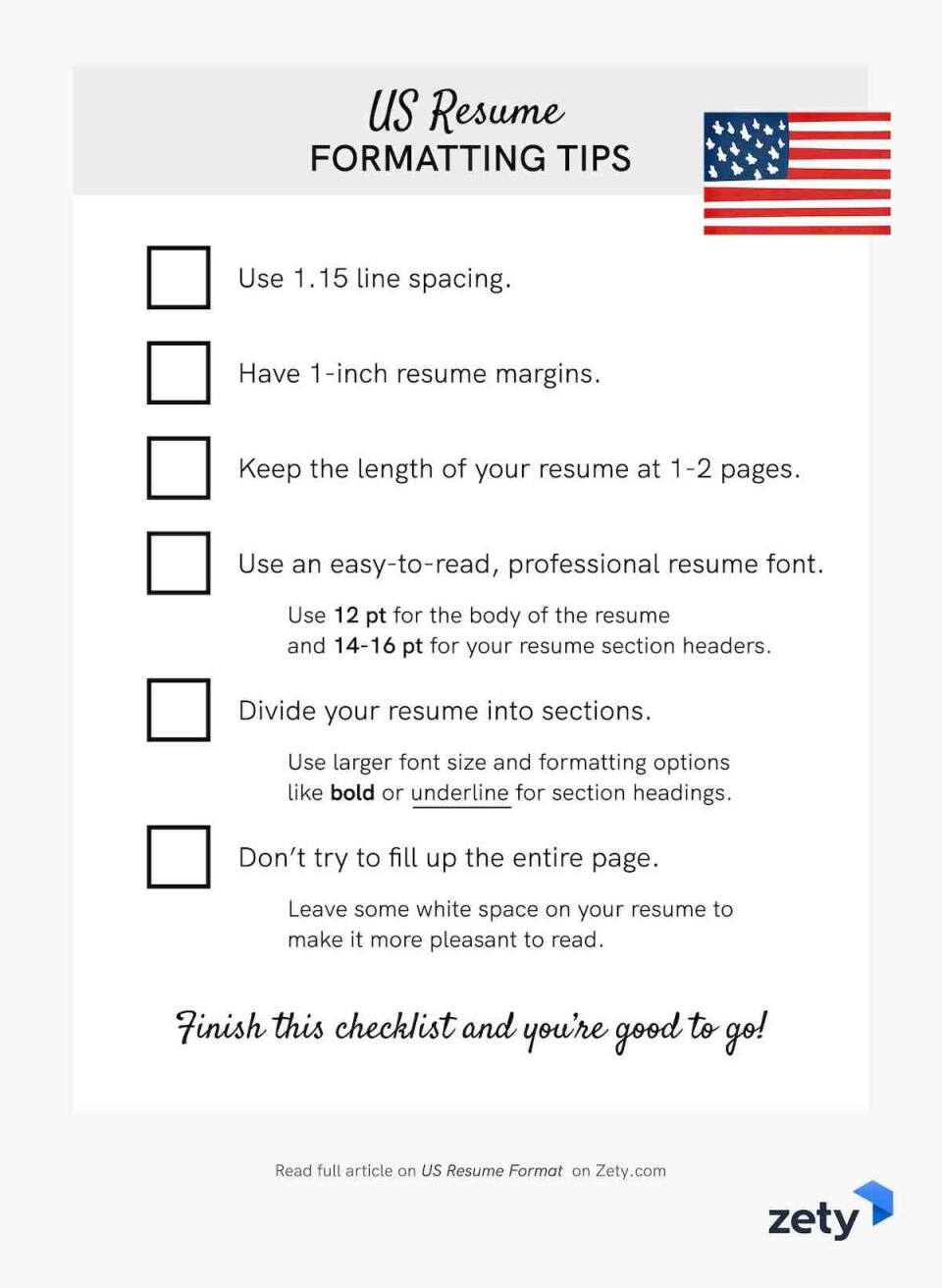
For the ultimate guide on what your resume format needs to shine, check this out: Best Resume Layout (+Examples)
Making a resume with our builder is incredibly simple. Follow our step-by-step guide, use ready-made content tailored to your job and have a resume ready in minutes.
When you’re done, our AI resume builder will score your resume and our resume checker will show you exactly how to improve it.
What Not to Include on American Resumes
There are things you should put on your resume as well as things you should not include on your resume. Here are some very important differences as to what should never be on an American resume:
1. Personal information on a US Resume
There is certain information that is considered normal on international resumes (e.g., biodata forms), but is actually a severe no-no on resumes in the USA.
You should remove all of the below information from your traditional resume:
- Date of birth
- Marital status
- Number of children
- Sex
- Parents’ names
- Personal identification numbers
- Photo
- Age
- Religion
- Ethnicity/Country of origin
All of these can be grounds for discrimination and so recruiters will simply reject any resumes with the above information without even reading them.
2. Authorization to Work in the US on a Resume
Some job seekers may think it’s a good idea to add a social security number or their immigrant status to their resume to prove that they can work legally in the US
It’s not.
Under federal law, it’s illegal for employers to ask for proof of your eligibility to work in the US until after giving you a job offer.
3. Phone Number on a US Resume
Add your phone number only if you have an American phone number you can be contacted under.
If you do, do not add the country prefix (+1). Your American phone number should be entered like this:507-350-1213 (mobile) or (952) 238-1027 (landline).
4. Address on a US Resume
Leave your address off of your resume. It’s not wise to have your detailed address floating around everywhere. Writing down the city in which you live plus the zip code should be enough (e.g. Peoria, AZ 85345).
If you live in a large metropolitan area, feel free to narrow it down to a given district or area (e.g. Lower Manhattan, New York, NY 10011).
6. References on a US Resume
It’s not customary to mention references on an American resume. The employer will ask for them if interested.
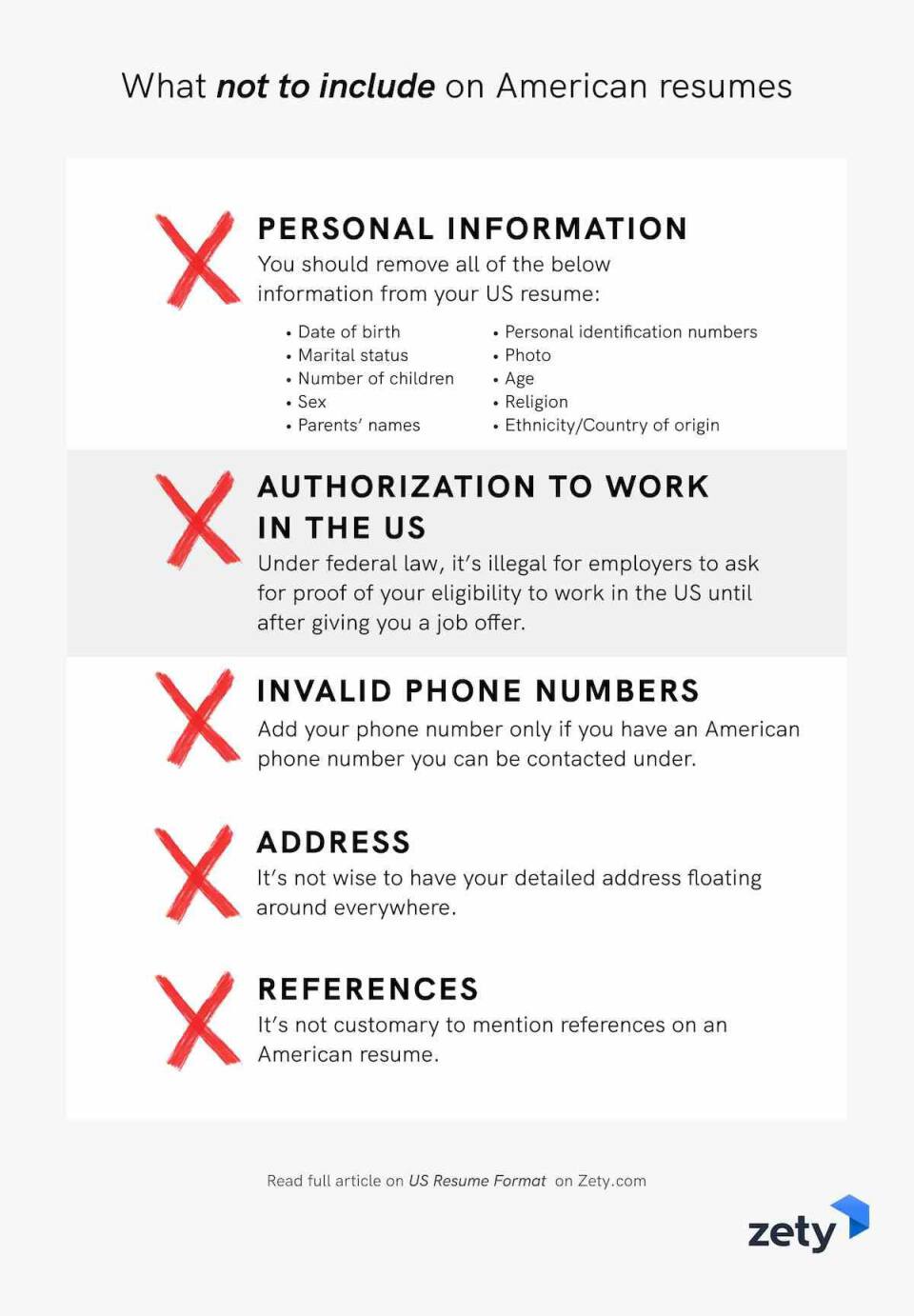
Finally, although cover letters aren't always required, it's good practice to write a cover letter for a job in the US.
How to Adapt a Foreign Resume for the US Job Market
If you're a foreign candidate, adapting your resume for the US job market can be a challenge, especially if you're used to different formatting standards and cultural expectations. US resumes are typically concise, achievement-driven, and optimized for Applicant Tracking Systems (ATS). Including unnecessary personal details or an incorrect resume parts could result in rejection before your resume is even reviewed.
To improve your chances, follow these key adjustments:
- Modify your contact information to reflect US norms. If you have a non-US phone number, consider getting a US-based number through services like Google Voice or Skype. Use a professional email address, ideally based on your name, and ensure your LinkedIn profile is updated to match your resume. Including a local address or stating "Relocating to [City, State]" can also reassure employers about your availability for in-person interviews.
- Adjust job titles and descriptions to align with US terminology. Some job titles and responsibilities may differ across countries, so research equivalent US job roles and use commonly recognized terms. Avoid direct translations and instead describe your experience in a way that is familiar to American employers. If applicable, highlight international experience, language skills, and cross-cultural competencies, which can be strong selling points in a globalized workforce.
- Clarify your degree by stating the US equivalent (e.g., "Equivalent to a US Bachelor’s Degree in Business"). Consider using credential evaluation services like WES (World Education Services) to validate your qualifications. Avoid using grading systems or degree titles that may be unclear to US employers, and instead, describe your education in familiar terms.
- If necessary, mention work eligibility in your cover letter. Do it particularly if you don't require sponsorship. Be prepared to discuss your legal status during interviews when asked, but focus on your skills and experience.
By adapting your resume to US standards, you’ll improve your chances of getting noticed by recruiters. Research job-specific expectations and tailor your application accordingly.
Looking for top universal resume tips? Look no more, visit our guide: Best Resume Tips for 2025
Plus, a great cover letter that matches your resume will give you an advantage over other candidates. You can write it in our cover letter builder here. Here's what it may look like:
See more cover letter templates and start writing.
Key Takeaway
No matter where you’re coming from, an American resume is not hugely different than the resume you probably already have.
Forget the special vocabulary for different parts of your resume, don’t worry that you don’t know the terminology.
Instead, when writing a resume for the US, keep your your eye on:
- Using the correct resume sections and order (header, profile, work experience, education, skills, additional sections).
- Formatting your resume correctly with proper fonts, spacing, and size.
- Making sure that you don’t include information that is unusual or illegal on your American resume.
Focus on putting your best foot forward in the right way and soon enough you’ll be walking through the door to your US interview!
Thanks for reading! Do you have any other questions concerning US style resumes? Let us know down below!
About Zety’s Editorial Process
This article has been reviewed by our editorial team to make sure it follows Zety's editorial guidelines. We’re committed to sharing our expertise and giving you trustworthy career advice tailored to your needs. High-quality content is what brings over 40 million readers to our site every year. But we don't stop there. Our team conducts original research to understand the job market better, and we pride ourselves on being quoted by top universities and prime media outlets from around the world.
